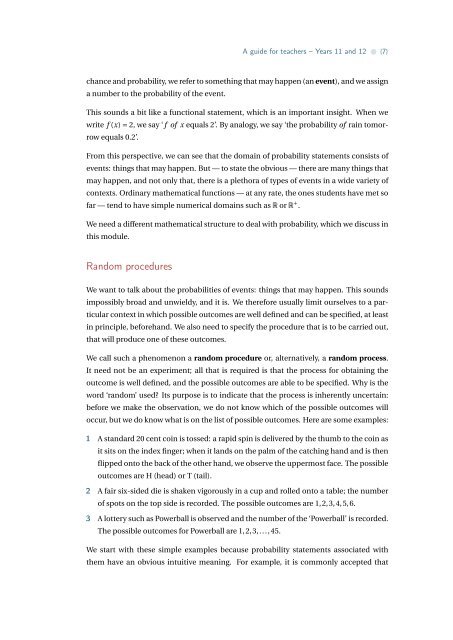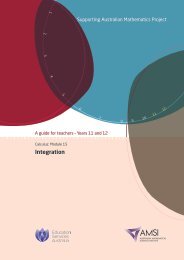Probability - the Australian Mathematical Sciences Institute
Probability - the Australian Mathematical Sciences Institute
Probability - the Australian Mathematical Sciences Institute
- No tags were found...
Create successful ePaper yourself
Turn your PDF publications into a flip-book with our unique Google optimized e-Paper software.
A guide for teachers – Years 11 and 12 • {7}chance and probability, we refer to something that may happen (an event), and we assigna number to <strong>the</strong> probability of <strong>the</strong> event.This sounds a bit like a functional statement, which is an important insight. When wewrite f (x) = 2, we say ‘f of x equals 2’. By analogy, we say ‘<strong>the</strong> probability of rain tomorrowequals 0.2’.From this perspective, we can see that <strong>the</strong> domain of probability statements consists ofevents: things that may happen. But — to state <strong>the</strong> obvious — <strong>the</strong>re are many things thatmay happen, and not only that, <strong>the</strong>re is a plethora of types of events in a wide variety ofcontexts. Ordinary ma<strong>the</strong>matical functions — at any rate, <strong>the</strong> ones students have met sofar — tend to have simple numerical domains such as R or R + .We need a different ma<strong>the</strong>matical structure to deal with probability, which we discuss inthis module.Random proceduresWe want to talk about <strong>the</strong> probabilities of events: things that may happen. This soundsimpossibly broad and unwieldy, and it is. We <strong>the</strong>refore usually limit ourselves to a particularcontext in which possible outcomes are well defined and can be specified, at leastin principle, beforehand. We also need to specify <strong>the</strong> procedure that is to be carried out,that will produce one of <strong>the</strong>se outcomes.We call such a phenomenon a random procedure or, alternatively, a random process.It need not be an experiment; all that is required is that <strong>the</strong> process for obtaining <strong>the</strong>outcome is well defined, and <strong>the</strong> possible outcomes are able to be specified. Why is <strong>the</strong>word ‘random’ used? Its purpose is to indicate that <strong>the</strong> process is inherently uncertain:before we make <strong>the</strong> observation, we do not know which of <strong>the</strong> possible outcomes willoccur, but we do know what is on <strong>the</strong> list of possible outcomes. Here are some examples:1 A standard 20 cent coin is tossed: a rapid spin is delivered by <strong>the</strong> thumb to <strong>the</strong> coin asit sits on <strong>the</strong> index finger; when it lands on <strong>the</strong> palm of <strong>the</strong> catching hand and is <strong>the</strong>nflipped onto <strong>the</strong> back of <strong>the</strong> o<strong>the</strong>r hand, we observe <strong>the</strong> uppermost face. The possibleoutcomes are H (head) or T (tail).2 A fair six-sided die is shaken vigorously in a cup and rolled onto a table; <strong>the</strong> numberof spots on <strong>the</strong> top side is recorded. The possible outcomes are 1,2,3,4,5,6.3 A lottery such as Powerball is observed and <strong>the</strong> number of <strong>the</strong> ‘Powerball’ is recorded.The possible outcomes for Powerball are 1,2,3,...,45.We start with <strong>the</strong>se simple examples because probability statements associated with<strong>the</strong>m have an obvious intuitive meaning. For example, it is commonly accepted that
















